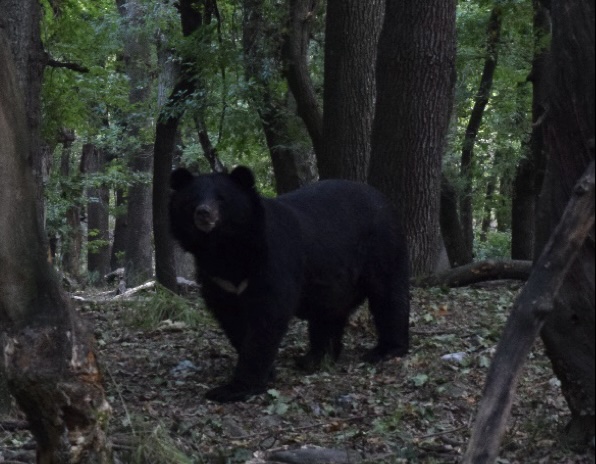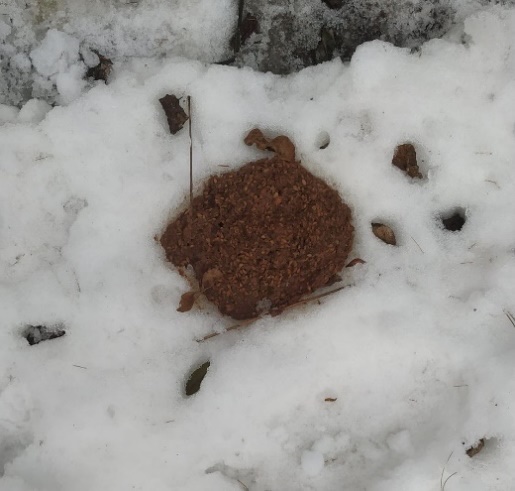Hibernation has been an important part of the life cycle of the Asiatic black bears in the Dachigam National Park. With the arrival of winter, these bears would retreat to their shelters and remain inactive for several months. However, the situation is different now. The ecosystem’s apex predator remains active throughout winter. Such a change is expected to affect the ecosystem – including not just the flora and fauna of the park, but also the local human communities.
The forested Himalayan slopes of Dachigam National Park in Jammu and Kashmir are home to the Asiatic black bear, a resilient species that has withstood the test of time despite numerous challenges. Nature has designed the species to survive the extremes of climate in the Himalayas, using hibernation as a tactic to escape the frigid winters.
In recent times, however, its behaviour has deviated drastically, with the hibernation period shortening over time. A more alarming change was observed in the winter of 2024-25. Evidence showed the bears remained active in the park throughout the winter, which implied that some bears were not hibernating at all. This discovery raises important questions: What are the causes and consequences of this drastic alteration in the behaviour of this species?
About The Asiatic Black Bear
The population of the Asiatic black bear (Ursus thibetanus) is not limited to Dachigam. It is a widely distributed species. In prehistoric times, it even lived in Europe. Today, its range stretches from southeastern Iran (its westernmost range) across Pakistan, Afghanistan, and the Himalayas in India, Nepal, and Bhutan to China, parts of Southeast Asia, the Russian Far East, the Korean Peninsula, and even some Japanese Islands.
Also Read: Beyond Tiger Centrism- A Holistic Approach To Biodiversity Conservation
While its range looks sprawling, the species is threatened and classified as “Vulnerable” on the IUCN Red List. Its population is highly fragmented and faces multiple pressures, including habitat loss, degradation, and poaching. Bears are hunted for their skin, fat, paws, nails, and gallbladders, which are in high demand in the illegal wildlife trade for traditional Chinese medicine (TCM) preparations. Shrinking habitats across its range push the bears into conflict with humans, resulting in their killing in extreme cases.
Dachigam remains one of the last strongholds of the Asiatic black bears. The park and its surroundings host one of the densest populations in Asia. Outside Jammu and Kashmir, the species is also found in Uttarakhand, Himachal Pradesh, and Northeast India. It is found at elevations ranging from 1,200m to 3,300m in the Himalayas. In some areas, its range overlaps with that of the Himalayan brown bear and the sloth bear. In India, it is protected under Schedule II of the Indian Wildlife (Protection) Act, 1972.
Also Read: India’s State Animals Are A Mixed Bag Of Happy And Sad Stories
Asiatic black bears are strongly built, burly animals. Males weigh almost twice as much as females, who weigh around 100 kilograms. Food availability and quality play vital roles in driving their movement and other behaviour, like hibernation patterns. Although omnivores, a significant portion of their diet in the Dachigam National Park’s Himalayan habitat comprises fruits, including apples, cherries, apricots, and peaches.
Before the 1990s, the species hibernated from late November or early December, when snowfall began, until late March or early April, when spring arrived. This dormant period helped the bears to survive harsh winters and food scarcity.

For hibernation, bears usually retreat to isolated, sheltered locations like caves, hollow trees, or dug-out ground dens. Males usually spend a shorter time in hibernation than females, who generally give birth in winter while still denning. In Dachigam, acorns become their preferred food choice before the hibernation period sets in. Rich in carbohydrates, they help the bear build the energy reserves needed for the dormant period.
Our Observation
Research has shown a gradual reduction in the hibernation period of Asiatic black bears in recent years in the Dachigam National Park. During the winter of 2024-25, however, both direct evidence through bear sightings and indirect evidence in the form of pugmarks and scats indicated that multiple Asiatic black bears were actively roaming in the park even in December and January. This observation meant that some bears were not hibernating at all, even after snowfall occurred, marking a greater deviation from the already shortened hibernation periods documented before.


Possible Causes
Several possible reasons could trigger this change in the behaviour of Dachigam’s Asiatic black bears.
One of the primary factors could be climate change. With global temperatures rising, winters in the Himalayas have been getting progressively warmer. If the ambient temperature does not fall low enough to trigger the bears’ metabolic slowdown, the physiological urge to hibernate may not occur. According to a 2021 study, Kashmir experienced a 2°C temperature rise between 1980 and 2020, representing a 0.5°C increase per decade. Thus, in the case of Dachigam’s bears, years of exposure to climate-induced changes could result in a transition from winter hibernation to year-round activity.
Another contributing factor could be the availability of food. Hibernation is closely tied to the scarcity of food resources, but if food remains accessible—whether due to delayed fruiting seasons, changing vegetation patterns, or access to anthropogenic waste—bears may choose to stay active. In the case of Dachigam National Park, increased food availability due to growing human presence, expansion of orchards, and the dumping of waste could influence the bears not to enter hibernation. A recent study has shown that built-up areas near the park have increased by 325% in the past 55 years (1965–2020). Thus, with more human influence around the park, the bears may find alternative food sources in and around human-dominated areas in winter, allowing the opportunistic omnivores to sustain themselves on food available in such areas.
Health issues such as disease, malnutrition, or physiological stress could also impact hibernation, though such factors are typically seen in individual bears rather than across populations.
Possible Consequences
Hibernation has been an important part of the life cycle of the Asiatic black bears in the Dachigam National Park. With the arrival of winter, these bears would retreat to their shelters and remain inactive for several months. Thus, the local ecology had adapted to thrive in the absence of the bears. However, the situation is different now. The ecosystem’s apex predator remains active throughout winter. Such a change is expected to affect the ecosystem – including not just the flora and fauna of the park, but also the local human communities.
Also Read: Local Communities Key To India’s Wildlife Conservation
With natural food being relatively scarce in winter, bears could become dependent on food available in and around human settlements, bringing them in close contact with people. Cases of crop depredation and attacks on livestock and people by the bears could increase. A study had shown that attacks by wild animals killed at least 67 people and injured 940 others in the Kashmir Valley over a period of five years. Around 80% of the cases were due to attacks by black bears. Thus, bears staying active through winter means heightened tension between humans and bears, causing losses of lives on both sides.
Moreover, staying active in cold conditions without adequate, high-quality food can pose serious health risks to the bears, potentially leading to starvation or increased vulnerability to illness. From a broader perspective, this behaviour change could be an early warning sign of larger climatic and ecological shifts affecting not just Asiatic black bears but other species in the region as well.
The Way Forward
Often called the ‘Maali‘ or the forest gardener, the Asiatic black bear is essential to maintaining the ecosystem in Dachigam National Park. These animals help disperse seeds by excreting and distributing the seeds of plants they eat, allowing the forest to thrive. By feeding on fruits and berries growing on trees, they also clear the path for sunlight to reach the plants growing at lower levels. These bears also occasionally act as scavengers, keeping the environment clean by consuming carcasses of dead and diseased animals.
Thus, protecting the Asiatic black bears of Dachigam National Park becomes vital. Presently, knowledge about the species is limited due to a lack of research targeted on these species. It is essential to undertake continuous scientific monitoring of the bears using tools like camera traps, GPS tracking, and systematic field observations. A detailed analysis of climatic conditions, snowfall patterns, and food availability in the region is also necessary to identify the root causes of the change in hibernation patterns.
Conservationists should educate local communities about proper waste management and ways to avoid conflict with the bears. Finally, conservation strategies may need to be revised if the bears continue to exhibit this behavioural change to ensure their long-term survival and welfare in the Dachigam National Park.
Disclaimer: The views expressed in this article are those of the authors solely. TheRise.co.in neither endorses nor is responsible for them. Reproducing this content without permission is prohibited.












